Photographs: Joshua Lott/Reuters Rediff Business Desk
September 15, 2008: Shockwaves went through the world financial markets as it was hit by the biggest bankruptcy known to man.
Dow Jones fell by more than 500 points, its biggest one-day drop since reopening after the September 11 attacks; more than 50 billion pounds was wiped out off London's bluechip shares as the FTSE 100 index tumbled by 213 points; Asian markets were on a selling frenzy, and 26,000 people around the world lost their jobs.
Lehman Brothers Holdings Inc, America's fourth-largest investment bank, hit by gargantuan $60 billion loss in bad real estate loans filed for bankruptcy.
And this happened just when the United States government decided that Lehman wasn't 'too big to fail'.
The fall of the 158-year-old institution that started cotton trade in the US before the American Civil War and financed the railroad that built the American nation, got battered by a large dose of bad luck, pride, arrogance and greed.
Lehman, while it was a large and complex business trading in a web of assets, supported 100 per cent mortgage loans to people with little visible means of support.
When interest rates soared, borrowers could no longer afford their monthly payments.
Other banks refused to trade with Lehman. Without the ability to trade and without investors prepared to bet on its long-term viability, Lehman effectively had no business.
How a banking giant fell . . .and died
Image: Another banking giant that almost collapsed.The main perpetrator
Lehman went under, holding assets of $639 billion against debts of $613 billion, making it the biggest corporate bankruptcy since WorldCom collapsed in 2002.
As central banks around the world battled to stabilise the system, the US Federal Reserve eased its rules for emergency lending. It announced that it would accept company shares in return for crisis loans for the first time.
Wall Street analysts believe that Lehman Brothers' collapse was the 'hubris' of Dick Fuld, the 62-year-old chief executive of Lehman Brothers, who did not take the tell-tale signs of impending doom seriously.
Fuld -- nicknamed 'The Gorilla' for his foul temper, intimidating presence and tough talk -- rejected many bids to save Lehman because he thought that the sinking giant was much bigger than Wall Street was giving it credit for and wanted to get more price for the sale of the company.
Analysts say if the bank was sold just a week before it went kaput, it could have been saved the ignominy of a bankruptcy, but Fuld was far too adamant to see reason.
Fuld, who is estimated to have lost more than $1 billion as a result of Lehman's failure, is believed to be in the process of setting up a financial consulting firm, Matrix Advisors.
How a banking giant fell . . .and died
Image: Erin Callan (left) and Joe Gregory.The other villains
Joe Gregory, former president and chief operating officer, Lehman Brothers was a close friend of Fuld. The pair worked together for 30 years, rising up through the bank's ranks and transforming it from a mere division of American Express to a serious contender on Wall Street.
While Fuld was in charge, Gregory was the fixer.
But in June 2008, after the bank's shares fell 25% Gregory ended the partnership.
Since his exit, he has become one of Lehman's largest individual creditors, filing a claim for $233 million in deferred compensation.
The rise and fall of Erin Callan, former chief financial officer, is perhaps one of the most enduring tales of Lehman's collapse.
A talented hedge fund adviser Callan was made the CFO in September 2007. But soon doubts were raised about her ability and others started querying the bank's capital position.
By September 2008, as Lehman collapsed, she was joining Credit Suisse to run its hedge fund advisory group. But since February 2009 she has been on indefinite paid leave.
Bart McDade, president and chief operating officer, joined Lehman in 1983. When Gregory fell, McDade was the obvious replacement.
He played a vital role in the bank's final hours, liaising with both potential buyers -- Bank of American and Barclays Capital -- as well as regulators.
After BarCap took over most of Lehman's US business, he stayed on to help with integration, leaving at the end of November. He joined Nomura, the Japanese bank which bought Lehman's London assets.
How a banking giant fell . . .and died
Image: A Lehman Brothers Holdings Inc employee writes a message on a portrait of Dick Fuld in New York.Photographs: Joshua Lott/Reuters
What went wrong
Lehman Brothers was once considered one of Wall Street's biggest dealers in fixed-interest trading. It was heavily invested in securities linked to the US sub-prime mortgage market.
When these investments were shunned as high risk, confidence in Lehman Brothers inevitably took a hit.
During the June to August period 2007, the bank had said it would make write downs of $700m as it adjusted the value of its investments in residential mortgages and commercial property.
A year later (in 2008) this figure soared to $7.8 billion. Lehman's share price plummeted more than 95 per cent.
Despite having access to cash reserves, worried investors battered the firm's shares after talks to raise billions of dollars from outside investors fell flat.
Lehman's collapse greatly intensified the financial crisis and contributed to the erosion of close to $10 trillion in market capitalisation from global equity markets in October 2008, the biggest monthly decline on record at the time.
How a banking giant fell . . .and died
Image: In 2003 and 2004, with the US housing boom well under way, Lehman bought five mortgage lenders.Beginning of the end
In 2003 and 2004, with the US housing boom well underway, Lehman bought five mortgage lenders, including subprime lender BNC Mortgage and Aurora Loan Services, which specialised in Alt-A loans (made to borrowers without full documentation).
Lehman reported record profits every year from 2005 to 2007.
In February 2007, the stock reached a record $86.18, giving Lehman a market capitalisation of close to $60 billion. However, by the first quarter of 2007, cracks in the US housing market were already becoming apparent as defaults on subprime mortgages rose to a seven-year high.
As the credit crisis erupted in August 2007 with the failure of two Bear Stearns hedge funds, Lehman's stock fell sharply. During that month, the company eliminated 2,500 mortgage-related jobs and shut down its BNC unit. In addition, it also closed offices of Alt-A lender Aurora in three states.
On June 9, Lehman announced a second-quarter loss of $2.8 billion.
As the world financial markets reeled, questions were raised as to why the US government decided to let Lehman fail, specially in the backdrop of its tacit support for Bear Stearns (which was acquired by JPMorgan Chase) in March 2008.
Its collapse also served as the catalyst for the purchase of Merrill Lynch by Bank of America on the very same day of September 15.
How a banking giant fell . . .and died
Image: Former US President George W Bush.Why US government did not help
The US government could have helped, but US Treasury Secretary Henry Paulson said that it would not use up any more taxpayer dollars to bail out Lehman Brothers as it would lead to investment banks getting away with their gambling ways.
Paulson had bailed out Fannie Mae, Freddie Mac and Bear Stearns, saying that if the government had not done so, the US housing loan market would have collapsed leading to gigantic losses for hundreds of banks all over the globe that have invested in US property.
Paulson thought that a brokerage major like Lehman, which did not have a direct connection with ordinary people who have taken on home loans, need not be bailed out as it would not cause any systemic damage to the US economy.
How a banking giant fell . . .and died
Image: Lehman Brothers' collapse was a major jolt to the world economy.The humble beginning
Lehman Brothers's was one of those extraordinary rags-to-riches story. Only here, it did not have the fairy tale ending.
Its humble origins can be traced to a small general store founded by German immigrant Henry Lehman in Montgomery, Alabama, in 1844.
In 1850, Henry Lehman and his brothers, Emanuel and Mayer, founded Lehman Brothers.
Lehman survived the railroad bankruptcies of the 1800s, the Great Depression of the 1930s, two world wars, a capital shortage when it was spun off by American Express in 1994, and the Long Term Capital Management collapse and Russian debt default of 1998.
However, despite its ability to survive past disasters, the collapse of the US housing market ultimately brought Lehman Brothers to its knees, as its exposure to subprime mortgage market proved to be a disastrous step.

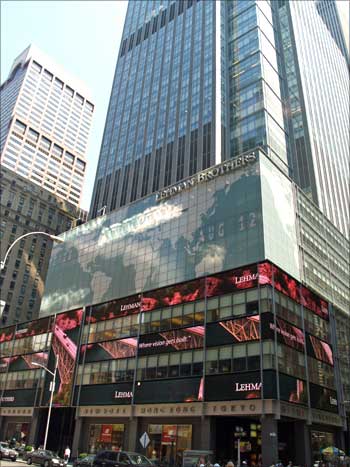
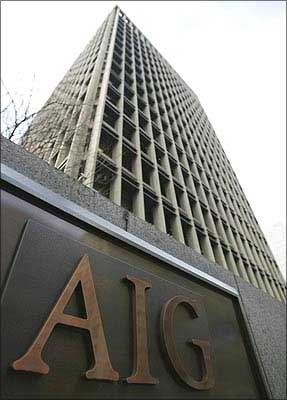
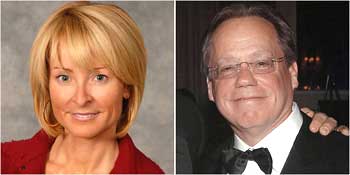
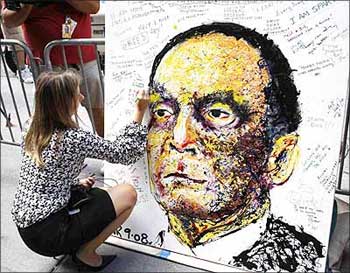

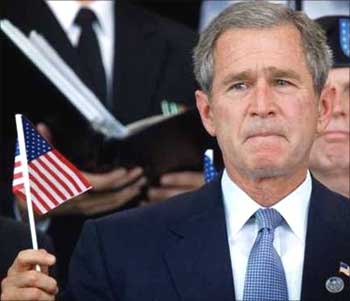
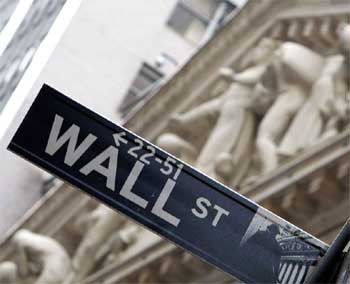
article